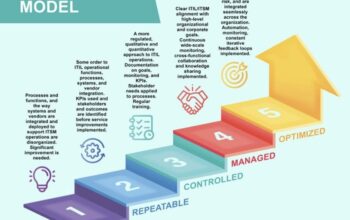People quickly get used to luxury. That’s the same with IT. Thanks to information technology, we can now work much faster and more efficiently than before. Who ever thinks about how much effort it used to take to type and post a letter? For this you needed at least a typewriter, a fresh typing ribbon and paper. Not to mention the tipp-ex to be able to correct errors. When the letter was finally ready, you needed an envelope, a stamp and the correct address. Then the letter went with the postman and a few days later the message could then be read. An e-mail has now been created and can be sent directly online. We almost never realize that so many things have become easier. On the other hand, we are immediately frustrated when a computer program is not working properly or the internet is out. Then we suddenly become aware of the importance of IT. The positive aspects of IT are consumed thoughtlessly and therefore remain unnoticed. Negative sides, on the other hand, are experienced intensively and therefore contribute much more strongly to the image. An IT manager in healthcare sketched a typical picture. “When the people in nursing started working with tablets, the first thing to do was to give it back because they had to get used to it. After that the work becomes easier, but they are quickly used to this. After that it only yields chagrin if it just doesn’t work or goes slower ”.
Everything is better at home
Many employees of large organizations work at home with better equipment and a faster internet connection than at work. In addition, the requirements with regard to safety at work are higher, which means that complex passwords and codes have to be used more often. An organization must take confidentiality, protocols and privacy into account and that does not always benefit the user experience. Because in the IT environment at home little account is taken of this type of business, it often works a lot faster more pleasantly. In addition, software is sometimes cumbersome and slow because large organizations work with many different programs that have to communicate with each other. Software is sometimes outdated. In the interviews of our research sometimes poignant examples emerged. For example, a municipality urged Microsoft to keep Windows XP up and running longer. While it had been announced years before that support for this program would stop. Ordering IT products is also easier at home. If we order a laptop in an online store, it will be delivered the next day. If we order something at work, it often takes a few weeks before we receive it. This discrepancy between the experiences at work and the private experience does not benefit the image of the IT department. In addition, IT people are generally unable to explain it properly. There are often valid reasons why something doesn’t work or goes slower.
Complex projects and high workload
The complexity of IT projects is often underestimated. One of the CIOs interviewed about this: “If we have a new kitchen installed, we almost automatically accept that it will be delivered late. While placing a kitchen has been about the same kind of task for decades. An IT project is almost never the same. We usually do something for the first time. Yet there is little understanding when a project ends. That is because people have no idea of the complexity of an IT project. ” Compared to installing a kitchen, the work required for an IT project is not very visible. Most people have no idea what is involved and cannot imagine this. IT staff are also generally poor in expectation management. Under pressure from the business, they are often tempted by unrealistic plans. This does not benefit the working relationship. An additional complicating factor is that most IT departments are understaffed. It is not easy for many organizations to find sufficient staff. The demand for IT staff is high throughout society. Finding staff with the right qualifications and retaining talent is a challenge. The demand for IT services from the organization is simultaneously increasing every year. Demand is also generally increasing faster than the available budget, with the result that projects are slowing down and the workload is constantly high. There is often little understanding for this in the rest of the organization. Also because IT knowledge is lacking.
Time for pride and appreciation
The above factors ensure that employees of an IT department are confronted with a lot of negativity. In general it can be said that IT people meet a lot of grumbles and little appreciation. This has an impact on the department. Negativity is contagious. If people experience a lot of negativity, this often results in a negative attitude towards the outside world, towards each other and towards themselves. This is also perceptible in many IT departments. This is undesirable and unjustified. IT staff is very involved and generally works on complex tasks under a high workload. If there is a crisis, people sometimes work day and night to get things back on track. Organizations have become completely dependent on a well-functioning IT environment. In the event of a malfunction or a hack, an entire organization becomes flat. The IT department therefore has a major responsibility. High quality is generally delivered with limited resources, which means that most processes within an organization run smoothly. It is time for IT people to receive the appreciation they deserve for this. If more recognition is given from within the organization, this will have an impact on the pride and positivity of IT departments. Because positivity is also contagious.
Tips:
- Make the importance of IT in the organization clear
Make clear what role IT plays in serving end users, the end customer and the end product. IT has a direct impact on the productivity and health of colleagues. There is also often direct influence on the end customer or end product. This relationship is not always very visible. Once I was allowed to give a presentation for the IT department of one of the major banks about customer enthusiasm, the employees wondered why this presentation was given to them. After all, they didn’t have contact with end customers, did they? However, showing film excerpts from consumers who were enthusiastic about the bank due to internet banking, privacy and security made it crystal clear that they did have a major impact on consumer enthusiasm. - Provide positive feedback from customers
When companies measure satisfaction with IT services, action is often only taken in the event of negative outcomes. IT organizations are used to responding to emergencies and that is of course of great importance. But it is a missed opportunity not to pay attention to positive signals. If you search for a while, they are often fully present. By also paying attention to compliments and other forms of appreciation from the customer, pride and flow are created and, moreover, it becomes much easier to create a customer-oriented culture. - Four successes
Many IT project organizations run from one project to the other. When a project is closed and evaluated, the issues that could have been better are often considered again. If a project has gone smoothly, has remained within budget or has made a customer happy, a quick transfer to the next project is made. That is a shame, because it is important to also consider successes and to take a moment to celebrate this together. Preferably also with colleagues from other departments who have contributed to the success. In this way a positive flow is created that extends even further than the own department. Also let external parties experience a four-moment moment if they played a role in this. This is also conducive to future cooperation. - Make room for positivity in consultation
It is not just IT departments that are primarily focused on problems. The problem focus can be found everywhere. Take a look at the 8-hour journal. The human brain is programmed to deal with danger. That still stems from the time that we constantly had to look over our shoulders to see if there was not a predator or enemy of another tribe behind us. This also means that positive matters rarely receive attention. Occasionally, attention is paid to positivity, for example if the manager has attended a course, but it often does not stick to a structural approach. That is why it is good to make room, even in periodic meetings, for discussing things that have gone well. It is advisable to start with this, because otherwise it often slips off the agenda. Moreover, it has been shown that a consultation works better if something positive is started. The brain goes like it were in a different mode. We become more creative, more tolerant towards others and more open to cooperation. - Give more sincere compliments
In addition to passing on positive customer feedback and celebrating success at project level, there are of course many more opportunities to show appreciation to colleagues. Every day there are colleagues who help us or deliver great performances. By consciously reflecting on this, for example at the beginning or the end of a working day, you first get into a better mood yourself. It evokes a feeling of pride that is easy to share with the relevant colleagues. By expressing an oral appreciation or by sending a text message or an e-mail message, you bring colleagues more in flow. Everyone likes to receive a compliment. As long as it is meant and shared with enthusiasm.



